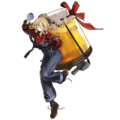Ranking of this Doll's specs relative to other Dolls of the same type.
Steyr ACR: Difference between revisions
No edit summary |
No edit summary |
||
| Line 10: | Line 10: | ||
| fullname = Steyr Advanced Combat Rifle | | fullname = Steyr Advanced Combat Rifle | ||
| voiceactor = {{voice actor name|Shiraishi Haruka}} | | voiceactor = {{voice actor name|Shiraishi Haruka}} | ||
| releasedon = {{doll_server_alias|server=CN|alias=S-ACR}}, {{doll_server_alias|server=TW|alias=S-ACR}}, {{doll_server_alias|server=KR|alias=S-ACR}}, {{doll_server_alias|server=EN|alias=S-ACR}}, {{doll_server_alias|server=JP|alias=S-ACR}} | | releasedon = {{doll_server_alias|server=CN|alias=S-ACR|year=2020|month=7}}, {{doll_server_alias|server=TW|alias=S-ACR}}, {{doll_server_alias|server=KR|alias=S-ACR}}, {{doll_server_alias|server=EN|alias=S-ACR}}, {{doll_server_alias|server=JP|alias=S-ACR}} | ||
|weaponinfo = | |weaponinfo = | ||
Latest revision as of 19:19, 19 September 2024
| Steyr ACR | Quotes |
Steyr ACR 313   | |
| Gun Information | |
|---|---|
| Full name | Steyr Advanced Combat Rifle |
| Country of origin | Austria |
| Manufacturer | Steyr Mannlicher |
| Game Information | |
| Faction | Griffin & Kryuger |
| Manufactured / Revised by |
I.O.P. |
| Voice actor | Shiraishi Haruka |
| Artist | 陆银 |
| Released on | CN (S-ACR) (2020-7), TW (S-ACR), KR (S-ACR), EN (S-ACR), JP (S-ACR) |
| Chibi Animation | |
| Variant:
Click the marked area to switch between animations. For details regarding animations, please see Animations on the Wiki. | |
| View page template | |
How to obtain[edit]
NORMALHEAVY Timer 4:08:00. See T-Doll Production for details.
DROP Not obtainable as a drop.
REWARD Not obtained as a reward
Exclusive Equipment[edit]
There is no exclusive equipment for this T-Doll.
Union Skill[edit]
There is no union skill for this T-Doll.
Stats / Data[edit]
| 62(x1) → 124(x1) / 620(x5) | 20(x1) / 60(x5) | 20(x1) / 60(x5) |
|
| ||||||||
|
| ||||||||
| 10 | 0 | ||||||||
| 20% | 50% | ||||||||
| 15 |
Ranking of this Doll's specs relative to every other Doll.
Weapon Background[edit]
The Steyr ACR was an experimental bullpup rifle developed by famous Austrian weapons designer Steyr-Mannlicher. It was Steyr's entry into the Advanced Combat Rifle program, and although the Steyr design proved effective, as did most of the weapons submitted, the entire ACR program ended with none of the entrants achieving performance 100% better than the M16A2, the military's baseline for a successful design.
The Advanced Combat Rifle program was started by the US Army in the late 1980's, with the main goal being to improve the hit probability of the average infantry soldier. The ACR was Steyr's entry, and it was one of the four weapons that made it to the third phase of testing, alongside Heckler and Koch's G11, Colt's ACR, and AAI Corporation's ACR (none of these rifles are to be confused with the later Bushmaster ACR). The program saw multiple developments in rifle technology, with most being centered around the ammunition: H&K used caseless ammunition with the G11, and the Colt design used duplex rounds (two smaller bullets inside a regular cartridge). Meanwhile, both the AAI rifle and the Steyr ACR decided to experiment with flechette ammunition. Flechettes (from the French fléchette, "small arrow" or "dart") had already been used by armed forces during World War 1, and had been tested by the US military before during the SPIW program of the 1960's. Back then, flechettes rounds had been considered a failure. By the time the ACR program began, rifle technology had come a long way, and their use as small-arms ammunition was once again being considered by manufacturers due to allegedly improved aerodynamics and armor penetration compared to regular bullets.[1]
The Steyr ACR bears some resemblance to Steyr's earlier rifle, the AUG. However, the ACR is rounder and the barrel is covered for almost its entire length, as opposed to the AUG where much of the barrel was exposed. Like the AUG, the ACR is a bullpup design, with the 24-round magazine located quite close to the buttstock of the gun. The ACR was also ambidextrous, due to having a bottom-side ejection port ahead of the magazine well, eliminating ejection problems with left- or right-handed shooters.
The Steyr employed a unique system to cycle ammunition: instead of driving rounds forward into the chamber and being held in place by a locking rotating bolt, the entire chamber traveled vertically the width of the round. After firing, the gases "blew" the chamber vertically downward, where a new round was forced into the chamber from the rear, forcing the old round out the ejection port ahead of the magazine. Springs then raised the chamber back into position where it was locked into a fixed block. The firing pin was fixed above the chamber, entering through a small hole and striking the primer to fire a round. The chamber was normally held in the "down" position, with the trigger releasing it to allow the springs to drive it upward and fire. The ACR's rate of fire was estimated at around 1,200 rounds per minute, firing in 3-round bursts.[2]
The ACR's ammunition was similarly unique. The rounds consisted of a .638 gram carbon steel flechette using a four-part spindle sabot contained in a telescoped polymer casing. It also featured a side-initiating ring primer. Unlike the G11, the propellant was not acting as the sabot, instead encasing the flechette and the sabot inside the case. When fired, the flechette rode in the sabot until it had exited the barrel. Being made of polymer, the ACR's ammo was significantly lighter that traditional brass-cased cartridges.[3]
During testing, the weapon performed well. Due to the extremely high velocity of the flechettes, the ACR boasted good killing power and armor-piercing capabilities, as well as low recoil. Only two main issues with the design were noted during testing. One was that the plastic cases had varying strengths, which has some effect on ballistics. This was considered to be a fairly minor problem, one they expected could be solved through better materials and quality control. The other issue was somewhat more difficult to solve: when the sabots left the barrel, they were still going quite fast, and presented a danger to other soldiers as well as to the shooter if they bounced off the ground when firing prone. Otherwise, reactions to the Steyr ACR were rather positive.
The ACR program was shut down in early 1987 without a winner, to come back later as the Objective Individual Combat Weapon program (the program that would birth the XM8, the XM29, and the M320 grenade launcher). The program's cancellation caused the ACR and its competitors to never leave the prototype stage. Flechette ammunition soon followed, with the last project using flechette ammunition (the Close Assault Weapon System, which birthed the HK CAWS shotgun) being canceled in the late 1980s. Only two ACR prototypes were ever made. One of them can be seen on exhibit at the National Infantry Museum in Fort Benning, Georgia. The other resides at the Steyr Mannlicher arms factory in Austria.
Character Background
A late stage tsundere with abundant destructive urges. She's eager about the mission but often brings disaster upon herself and makes "surprises" for her teammates. On the surface, she looks like she can't be bothered with her big sister AR AUGAUGAUG's nagging, but in truth she stores each and every one of her big sister's smiles in her neural cloud.
Gallery
Main artwork
Gallery consisting of artworks used primarily in-game. For information on how to obtain certain costumes, see Skin Catalogue.
-
Profile image
-
Full artwork
-
Full damaged artwork
-
"Honey Wish" full artwork
-
"Honey Wish" full damaged artwork
-
"Wind-Chasing Witch" full artwork
-
"Wind-Chasing Witch" full damaged artwork
Alternative artwork
Alternate gallery consisting of artworks with slight alterations as well as miscellaneous artworks.
-
Official character sheet of Steyr ACR
References[edit]
| List of T-Dolls |
|---|




















